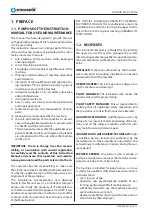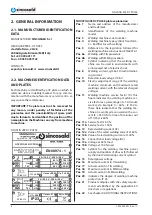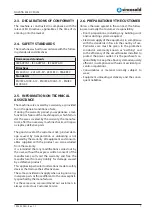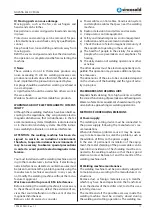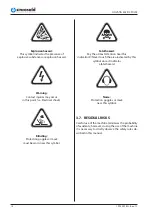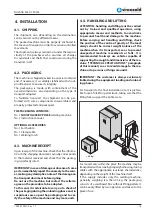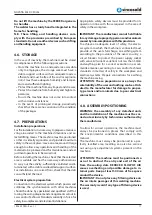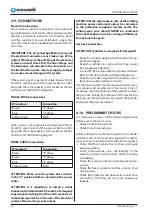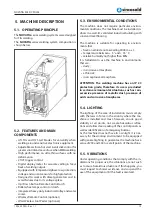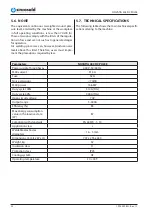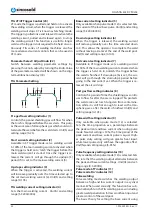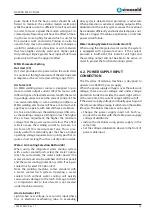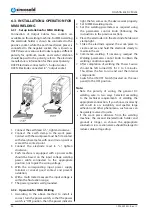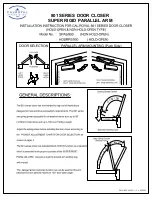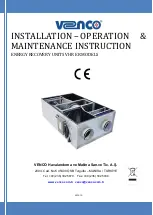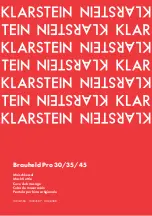
which covers all exposed surfaces of the body.
Wear protective clothing and welder gloves, head-
gear and high shoes with safety tip. Button the shirt
collars and pocket flaps and wear trousers without
cuff to avoid the entry of sparks and slag.
Wear a mask with protective glass on the outside and
adiactinic glass filter inside. This is MANDATORY for
welding operations, in order to protect the eyes from
radiant energy and volatile metals. Replace the pro-
tective glass if it is broken, pitted or spotted. Avoid
oily or greasy clothes; a spark could ignite them. In-
candescent metal parts, such as work pieces, should
always be handled with gloves.
First aid equipment and a qualified person should be
available for each shift, unless there are health facili-
ties nearby for immediate treatment of eye and skin
burns.
G) Fumes
Welding operations produce harmful fumes and met-
al dust, which can damage health:
- Do not work in spaces without adequate ventila-
tion. Keep your head out of the fumes.
- In closed environments, use suitable exhaust fans.
If ventilation is not adequate, use suitable respi-
rators.
- Clean the material to be welded if there are solvents
or halogen degreasers, which give rise to toxic gases.
During welding, some chlorinated solvents can de-
compose in the presence of radiation emitted by the
electric arc and produce phosgene gas.
- Do not weld coated metals or those containing lead,
graphite, cadmium, zinc, chromium, mercury or be-
ryllium, unless a suitable respirator is available.
The electric arc generates ozone. Prolonged expo-
sure, in environments with high concentrations of
ozone, can cause headaches, irritation of the nose,
throat and eyes and severe congestion and chest
pain.
IMPORTANT: DO NOT USE OXYGEN FOR VENTILA-
TION!!!
Gas leaks must be avoided in small spaces. Large gas
leaks can dangerously change the oxygen concentra-
tion.
Do not place cylinders in small spaces.
DO NOT WELD or cut where solvent vapours can
be drawn into the welding atmosphere or if radiant
energy can penetrate into atmospheres containing
even tiny amounts of trichloroethylene and perchlo-
rethylene.
- Do not lift the cylinders from the ground by hold-
ing them by the valve or by the cap, or by using
chains, slings or magnets.
- Do not attempt to mix any gas inside the cylinders.
- Never refill the cylinders, but have them refilled by
specialised companies.
- Do not modify or exchange the cylinder fittings.
2) Pressure regulators:
- Keep pressure regulators in good condition. Dam-
aged regulators can cause damage or serious ac-
cidents; they must be repaired only by qualified
personnel.
- Do not use regulators for gases other than those
for which they were manufactured.
- Never use a regulator that leaks or appears physi-
cally damaged.
- Never lubricate a regulator with oil or grease.
3) Hoses:
- Replace hoses that appear damaged.
- Keep hoses taut to avoid accidental creases.
- Keep the excess hose collected and keep it out of
the work area to prevent damage.
E) Fire
- Avoid igniting fire due to sparks and hot slag or
incandescent parts.
- Ensure that appropriate fire protection devices are
available near the welding area.
- Remove flammable and combustible materials
from the welding area and the surrounding area
(minimum 10 metres).
- Do not weld on fuel and lubricant containers, even
if empty; these must be carefully cleaned before
being welded.
- Allow the welded piece to cool before touching it
or putting it in contact with combustible or flam-
mable materials.
- Do not weld on parts with cavities containing
flammable materials.
- Do not operate in atmospheres with high concen-
trations of combustible vapours, flammable gases
or dust.
- Always check the work area thirty minutes af-
ter the end of welding operations to ensure that
there are no fires.
- Do not keep combustible materials such as light-
ers or matches in your pocket.
F) Burns
Protect the skin against burns caused by ultraviolet
radiation emitted by the electric arc, by sparks and
slag from molten metal, using fireproof clothing,
10
1.995.229 EN - Rev. 1.1
NOVATIG 403 DC PULSE




